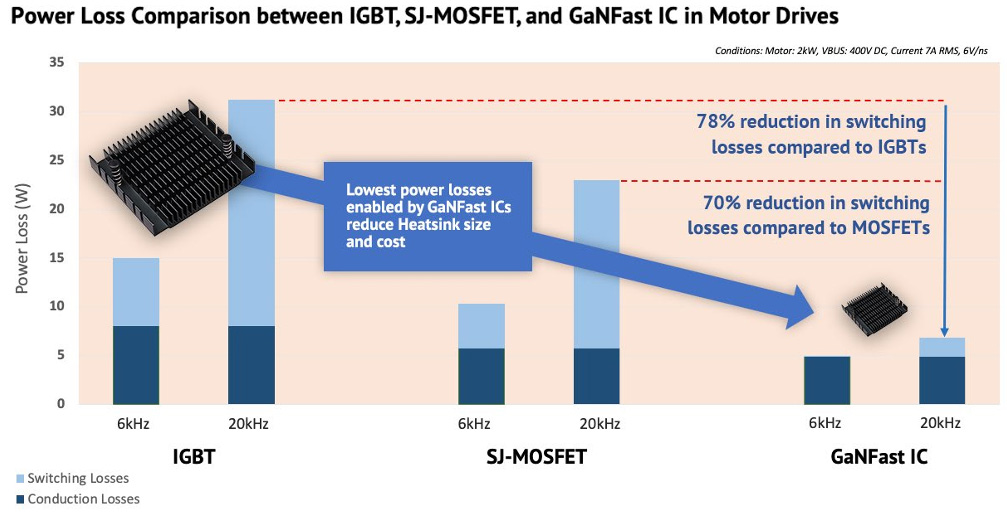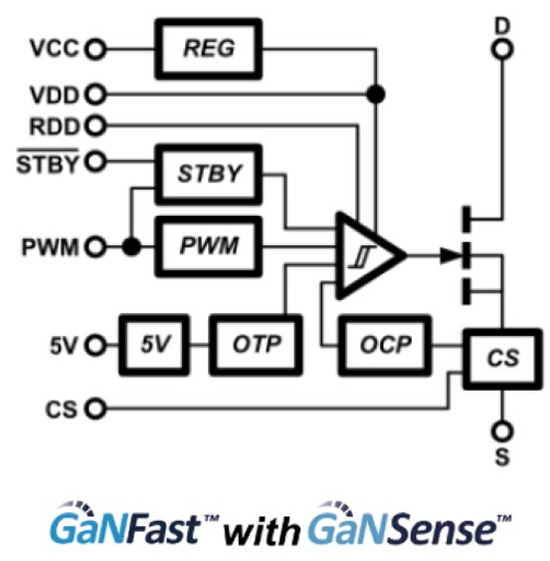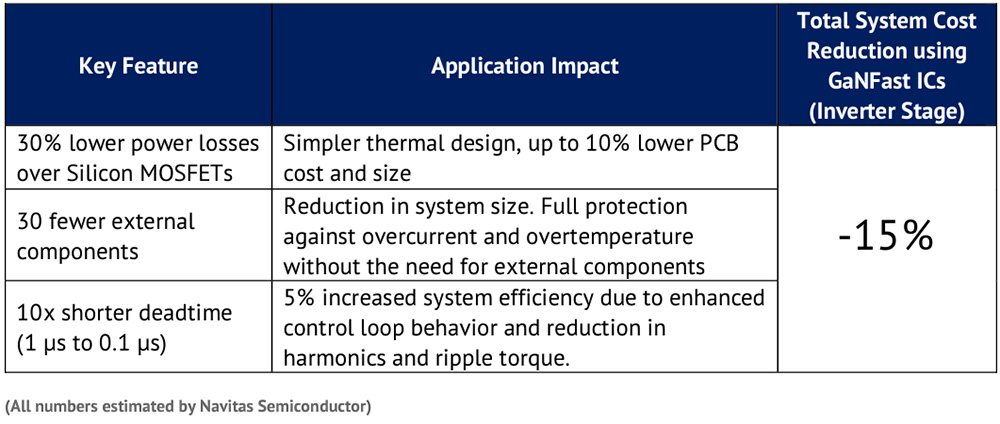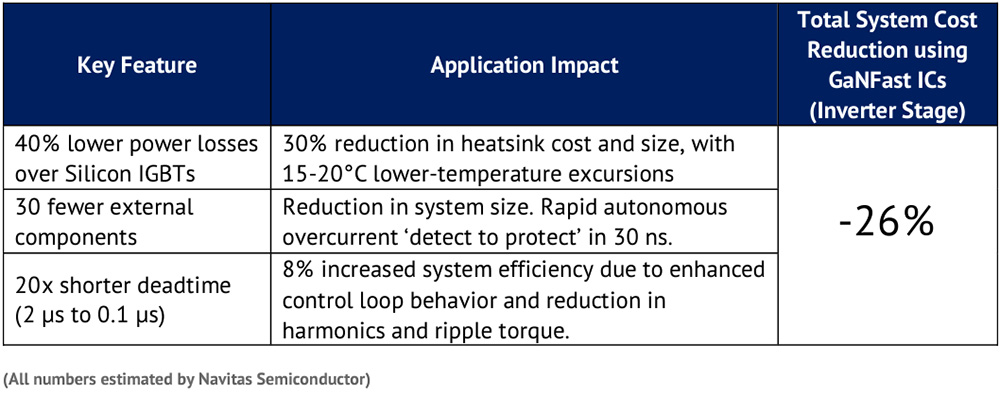Fully-Protected GaN Power ICs Deliver Robustness and Lower System Costs to Motor Drives
![27_Pdf_File_Type_Adobe_logo_logos-512[1]](https://navitassemi.com/wp-content/uploads/2020/12/27_Pdf_File_Type_Adobe_logo_logos-5121.png)
Fully-Protected GaN Power ICs Deliver Robustness and Lower System Costs to Motor Drives
By Alfred Hesener, Senior Director Industrial and Consumer
Navitas’ GaNFast™ power ICs with GaNSense™ technology enable highest protection and advanced sensing
Motor Drives: Next-Generation Solutions to “Electrify Our World™”
Motor drives consume nearly 50% of the electricity produced in Europe [1]. Governments have therefore created regulations and standards to make sure electricity is consumed as efficiently as possible with the least impact and disruptions to the electrical supply grid. Variable-speed drives (VSD) are now common in the industry as they reduce energy usage up to 90% compared to older constant-speed induction-motors [2], whilst having the added benefits of reduced motor size, improved dynamic performance and reliability [9].
Standards such as IEC 61000 were created to support the electrical-supply grid in terms of immunity and emissions of electrical equipment, as large inductive loads presented by motor drives can significantly impact local-grid stability. To address these standards, various techniques have been implemented in the motor-drive system, including active power-factor correction (PFC), which modulates the distorted wave back into a sinusoidal wave to maximize real power from the grid supply.
GaN Improves Both Performance and Cost
Gallium nitride (GaN) is a wide-bandgap semiconductor which offers superior characteristics compared to older silicon equivalents, including the ability to switch up to 20x faster and increase power density by over 3x times. Implementing GaN power devices into a motor-drive system for PFC and inverter stages provides a significant reduction in power losses, resulting in a lower total cost of ownership (TCO) of the complete motor-drive supply-chain [3].

Table 1: Total cost of ownership (TCO) for a typical motor-drive system and benefits using GaNFast IC technology
GaN FETs have zero reverse-recovery charge, which allows for extremely fast switching, resulting in 4-5x-lower switching losses than silicon IGBTS and MOSFETs and approximately 50% reduction in total power losses. This reduction in power translates to reduced dissipated heat from the device, allowing heatsinks to be reduced in size – or even eliminated in lower-power drives. In 2021, the cost of heatsink-grade machined aluminum reached a 13-year high, with a price of around $8/kg, so minimizing heatsink requirements allows significant savings on the total system cost. In addition, lower shipping costs result due to reduced system weight.

Figure 1: Navitas GaNFast ICs exhibit lowest power losses across all switching frequencies compared to silicon IGBTs and MOSFETs (Source: Navitas Semiconductor calculations)
The combination of extremely-low switching losses and no reverse-recovery enables a new degree of freedom in switching frequencies for VSDs. Motor-drive applications were designed to have a low switching frequency to reduce switching losses, however implementing GaN enables switching frequencies to increase significantly from under 16 kHz to over 65 kHz, leading to several major advantages. First, the motor-winding inductance can be reduced, which reduces motor size and increases efficiency due to the reduced Ohmic and high-frequency losses in the windings. Second, the entire spectrum of conducted noise created by the VSD and fed back into the grid is shifted higher in frequency. This allows for smaller EMI filter components and cost/size reduction of the input filter. A third advantage is the improved performance of dynamic operation due to the increased control-loop bandwidth. This is beneficial for highly-dynamic systems such as industrial sewing machines, wire-bonders and servos where accuracy and speed can be improved significantly.
In real-world applications such as motor drives, abnormal operating conditions can lead to high transient voltages across the power switches. Lighting strikes on power lines are a common issue, but also switching on or off large electrical loads. Discrete GaN FETs are sensitive to these overvoltage conditions but monolithic GaN integration enables the addition of robust, 2 kV electrostatic discharge (ESD) diodes. Additionally, it advisable to clamp the maximum voltage to within the breakdown voltage of the device – the common practice today for silicon IGBTs. Navitas’ GaN ICs are rated for continuous voltages of 650 V or 700 V and transient voltages up to 800 V, significantly higher than typical voltage-spikes in everyday systems, making them very robust.
Integration Improves Efficiency, Control, and Robustness for Motor Drives
GaNFast ICs with GaNSense technology integrate the performance of GaN power with driver, protection, and dynamic-sensing capabilities, making them ideal for high-reliability motor-drive applications. The optimized gate-drive circuit with associated voltage regulator and protection circuits, such as over-temperature and over-current detection has the autonomous ability to selfprotect. All these features are fully integrated, resulting in the superior performance with highest reliability. The input signal can be controlled with a simple digital signal, eliminating external components, and reducing PCB area. This becomes beneficial for compact motor drives, where the complete electronic system can fit in the motor housing [4,5,6].

Figure 2: Simplified block diagram of a fully-integrated GaNFast IC with GaNSense technology from Navitas
Compared to discrete silicon or discrete GaN approaches, GaNSense technology can ‘detect and protect’ in only 30 ns – i.e. up to 6x faster than silicon or GaN discretes, improving system-level reliability.
Integration of temperature control on the power switches offers higher precision and real-time sensing compared to a traditional low-precision temperature sensor on a heatsink. This is critical for motor-drive applications that use active cooling with liquid or forced air. The built-in overtemperature protection circuit will turn off the GaN IC when set temperatures are exceeded, enabling fast protection of the system.
The benefit of loss-less current sensing in GaNSense technology eliminates the need for large and expensive shunt resistors, significantly reducing system size and cost, whilst maintaining fast overcurrent protection for system robustness as required in industrial motor drives for factory automation.
Additionally, the total component count is lowered, yielding a significantly lower FIT (failures in time) rate and improvement in system reliability. Navitas recently announced a 20-year limited warranty on its products, which is an industry first to highlight their exceptional reliability.
Low-Power Motor Drive – Circulator Pump
Many houses and buildings in colder climates are heated through radiators supplied with hot water from a central heater. A small circulator pump (<70W) brings the hot water to the radiators and consumes a significant amount of electrical energy, especially in winter. However, this is not just a simple water pump humming away in a corner – sophisticated control algorithms adjust the pump operation based on the differential pressure in the tubing to reduce power consumption.
Additionally, the water circulating in the tubes along with the thermostatic valves and fittings can create noise and vibration that the pump will try to minimize. These features improve the energy consumption in many different pump applications across the entire power range of pumps [7].
Implementing GaNFast ICs with GaNSense technology reduces system size due to exceptionallylow power losses and a high level of integration, enabling a much more compact solution to fit within the motor and pump case. Additionally, the enhanced controllability due to GaNFast’s highswitching frequencies enables improved vibration damping of the water column and lower electricity consumption.

Table 2: GaNFast ICs with GaNSense technology enable 5% higher system efficiency and 15% reduction in total system cost in low-power drives
Higher-Power Motor Drive – Washing Machine Drum Drive
The motor-drive subsystem to spin the washing machine drum demands high robustness, with washing programs continuously optimized to save detergent, water, and electricity. The trend to move away from traditional belt-driven systems towards direct drive, where a large flat discshaped motor is attached to the drum directly, allows for larger drums and removes the belt with its limited lifetime and additional vibration. Since the motor has considerably higher torque, particularly at low speed, operation across all washing programs is improved, including better handling of vibrations and uneven distribution of the load. These direct drive motors (~600 W) have many poles, therefore require faster switching-frequencies to reach the desired spinning speed compared to traditional BLDC belt drive motors [8].
GaNFast ICs with GaNSense technology offer lower power losses, full protection and dynamic sensing resulting in smaller heatsinks, lower weight, and larger washing capacity. With no reverserecovery, high frequencies for high-pole-count motors can be achieved even with moderate switching frequencies due to the very short dead-time ideally required for the half bridges. This also reduces audible noise and power losses in the motor. Integrated over-temperature and overcurrent protection significantly improves the robustness of the appliance, dealing with uneven distribution of the clothes in the drum at start-up, while reducing external component count.

Table 3: GaNFast ICs with GaNSense technology enable 8% higher system efficiency and 26% reduction in total system cost in higher-power drives
Summary: GaNFast ICs Drive Up Efficiency, Drive Down Cost
Every motor has different requirements, but the trends are in the same direction: improved efficiency, better performance, and lower cost. GaNFast ICs enable higher system-efficiencies and improve performance, whilst reducing total cost of ownership of the complete system. GaNFast ICs with GaNSense technology offer the highest level of integration – drive, power, protection, and sensing to ensure superior performance with highest reliability and robustness required in motordrive applications.
References
1) ec.europa.eu, „Electric motors and variable speed drives“
2) Engie, „5 Reasons to Install Energy-Saving VFDs“
3) Overview on EU regulations, e.g., https://www.coolproducts.eu/product/washingmachines/
4) Navitas Semiconductor, Application note AN-015, Dec 2021
5) US patent 8390241 „Motor drive based on III Nitride devices“
6) Navitas Semiconductor, „GaNFast™ Power IC Solutions for EV, Solar & Industrial“, Bodo’s Wide Bandgap Event, Dec 2021
7) Navitas Semiconductor, „GaNFast™ Architecture, Performance in High-Power Systems“, Bodo’s Wide Bandgap Event, Dec 2021
8) Smart Water Magazine on smart solutions from Grundfos, 2019, https://smartwatermagazine.com/news/grundfos/grundfoss-smart-water-solution-deployed-over7000-villas-across-uae
9) LG (South Korea), „6 Motion direct drive“, https://www.lg.com/uk/washing-machines/lg-aidd